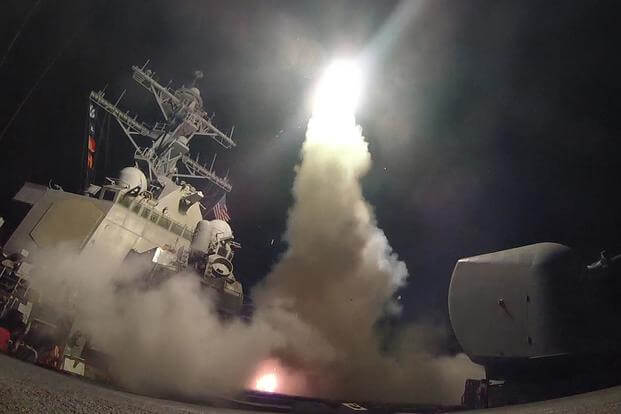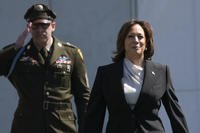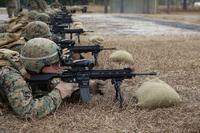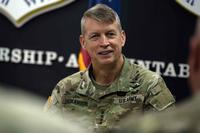Russia on Friday scrapped the agreement to "deconflict" air operations over Syria, increasing the risk to U.S. pilots in the aftermath of cruise missile strikes launched by Navy destroyers on a Syrian air base.
Russian President Vladimir Putin's spokesman said that the possibility of conflict between U.S. and Russian aircraft had "significantly increased" as the result of Moscow's decision to pull out of the 2015 deconfliction agreement in response to the U.S. attack on the Sharyat air base north of Damascus.
Related: US Launches Cruise Missile Strike on Syria
Putin views the U.S. strikes on Syria as "aggression against a sovereign state in violation of the norms of international law," said Dmitry Peskov, the Kremlin spokesman.
U.S. officials said initial bomb damage assessments showed that the strikes by 59 Tomahawk cruise missiles launched by the destroyers Ross and Porter had inflicted "severe" damage on the base and destroyed as many as 20 Syrian aircraft.
Russian Maj. Gen. Igor Konashenkov, a Defense Ministry spokesman, disputed the U.S. claims and said the overall effects of the missile strikes had been "quite poor," according to the Russian news outlet RT.
At least 13 people were killed in the missile strikes, including five Syrian soldiers on the base and eight civilians in areas surrounding the facility, said Talal al-Barazi, governor of Homs province, according to official Syrian media. His claims could not be independently confirmed.
Konashenkov said that six aging MiG-23 "Flogger" fighters had been destroyed, but he did not specify whether they were Syrian or Russian jets. He also said that of the 59 TLAMs, or Tomahawk Land Attack Missiles, "only 23 of them reached the Syrian air base."
Konashenkov and Syrian President Bashar al-Assad also repeated denials that Syrian warplanes carried out the alleged chemical munitions attack on the northwestern town of Khan Sheikhoun on Tuesday that killed more than 70 and injured hundreds. Russia also called for an urgent meeting of the United Nations Security Council to condemn the U.S. action.
Assad told the Syrian state news agency that the U.S. missile strikes amounted to "unjust and arrogant aggression" and pledged to escalate his efforts to "crush" rebel groups seeking to topple his regime.
In announcing the strikes Thursday night at his Mar-a-Lago estate in Florida, where he was meeting with Chinese President Xi Jinping, Trump said the attacks were in the "national security interest of the United States to prevent and deter the spread and use of deadly chemical weapons."
"There can be no dispute that Syria used banned chemical weapons, violated its obligations under the Chemical Weapons Convention, and ignored the urging of the U.N. Security Council," Trump said.
The so-called "deconfliction channel" for air operations over Syria that the Russians now say has been cut off was used Thursday night to warn Russians at the Sharyat air base that cruise missiles were about to be launched, Navy Capt. Jeff Davis, a Pentagon spokesman, said at a briefing after the attacks.
"Russian forces were notified in advance of the strike using the established deconfliction line," Davis said. "U.S. military planners took precautions to minimize risk to Russian or Syrian personnel located at the airfield."
In Florida, where he was joining talks with Trump and President Xi, Secretary of State Rex Tillerson confirmed that the U.S. used the deconfliction channel to warn the Russians but said no attempts were made to contact Putin directly. He predicted that the strikes would win international approval.
"My expectation is that all of those parties, with the exception of Bashar al-Assad and perhaps Russia, I think are going to applaud this particular action," he said.
The overriding goal of the U.S. in Syria is the defeat of the Islamic State of Iraq and Syria, Tillerson said, but eliminating the ISIS threat could also be a first step in pursuing a peace settlement that would speed the return of refugees and eventually lead to the ouster of Assad.
Only last week, Tillerson was saying that Assad's fate was up to the Syrian people. However, "To defeat ISIS is to begin to stabilize areas of Syria, stabilize areas in the south of Syria, stabilize areas around Raqqa through cease-fire agreements between the Syrian regime forces and opposition forces," he said.
"In the midst of that, through the Geneva process, we will start a political process to resolve Syria's future in terms of its governance structure and that ultimately, in our view, will lead to a resolution of Bashar al-Assad's departure," Tillerson said.
-- Richard Sisk can be reached at Richard.Sisk@Military.com.
Related video:
The U.S. military launched a total of 59 Tomahawk cruise missiles from two naval destroyers in the eastern Mediterranean Sea around 4:40 a.m. local time on April 7, 2017.




























